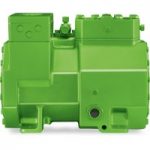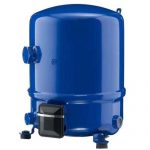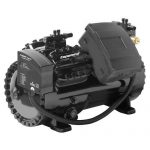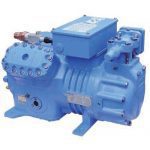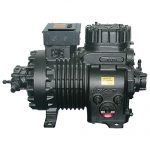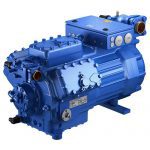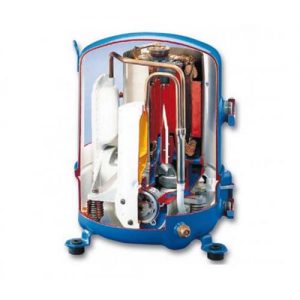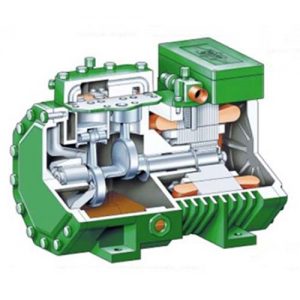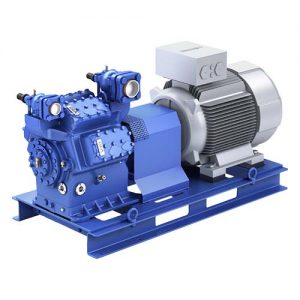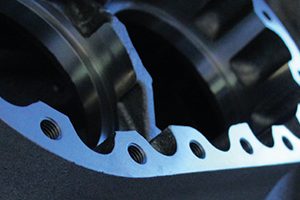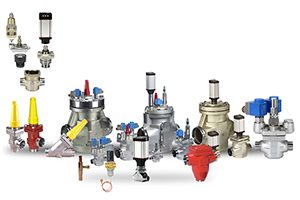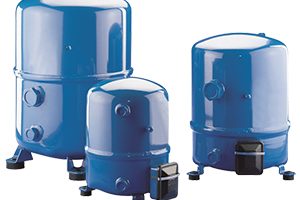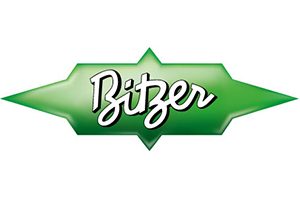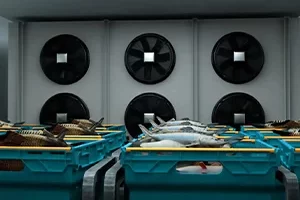Refrigeration Compressors from Leading American, European, and Asian Brands
Refrigeration compressors are essential components of cold room systems, available in various types, including screw, piston, and scroll. They can use ammonia or freon refrigerants and come in hermetic, semi-hermetic, or open designs. Compressors are also classified into single-stage or two-stage compression based on their function. Key brands offering reliable refrigeration compressors include Grasso, Sabroe, Mycom, Danfoss, Copeland, Xuemei, Bitzer, Refcomp, and Bock, catering to a variety of needs and budgets.
Structure of Cold Room Compressors
Cold storage compressors are categorized into three types: hermetic, semi-hermetic, and open. Each model differs in the arrangement and placement of the electric motor and internal compressor components.
Hermetic Compressor
Hermetic compressors feature both the compressor and the electric motor housed within a welded steel shell, creating a completely sealed unit. This design allows for quiet and efficient operation, as external sealing is unnecessary. Hermetic compressors are also considered safe regarding refrigerant leakage. However, accessing the compressor compartment for repairs is typically not possible, complicating maintenance tasks.
| Advantages | Disadvantages |
| Average efficiency/Quiet operation/Minimal refrigerant leakage/Simple structure | Difficult maintenance/Complete replacement required in case of failure |
Semi Hermetic Compressor
In semi-hermetic compressors, both the compressor and the electric motor are housed within a shell secured by a cap and screws. Similar to hermetic compressors, the electric motor is contained within the compressor housing; however, semi-hermetic models allow for replaceable parts. This means that if the motor or other components fail, they can be replaced without needing to replace the entire compressor.
The shell is assembled with bolts and nuts, facilitating easier repairs. Additionally, the presence of a compressor oil pump enhances smooth operation and extends the compressor’s lifespan. Notably, semi-hermetic compressors often exhibit higher efficiency than their hermetic counterparts.
| Advantages | Disadvantages |
| Easier maintenance compared to hermetic compressors/Replaceable parts for reduced downtime/Higher efficiency | Higher cost than hermetic compressors/Increased power consumption |
Open Compressor
Open compressors feature a separate electric motor and compressor, linked by a coupling. This design allows for straightforward maintenance and repairs due to easy access to the components
| Advantages | Disadvantages |
| Easy maintenance/Ability to replace parts separately/Higher efficiency | Noise and vibration/Increased risk of refrigerant leaks/Higher initial cost |
Below is a comparison of cold storage compressors categorized by their construction type:
| Open Compressor | Semi-Hermetic Compressor | Hermetic Compressor | Feature |
| Open | Semi-sealed | Completely sealed | Sealing |
| Easy | Average | Difficult | Maintenance |
| Higher | High | Average | Efficiency |
| Higher | Average | Lower | Cost |
| Higher | Average | Lower | Sound |
Refrigeration Compressor Performance
Compressors are divided into two groups, rotary or reciprocating.
Rotary compressors
Screw Compressors and Scroll Compressors fall under the category of rotary compressors.
- Screw Compressors: These utilize two interlocking rotors (male and female) housed within a casing. As the rotors rotate, the incoming gas is trapped and compressed as it moves toward the outlet. Key advantages of screw compressors include high efficiency, low vibration, low noise, and the ability to operate continuously. They are commonly employed in large industrial refrigeration systems.
- Scroll Compressors: Scroll compressors consist of two spiral scrolls—one stationary and the other rotating around it. The rotation of the moving scroll traps the incoming gas and compresses it before directing it to the outlet. Scroll compressors feature a simple design with compact dimensions and minimal vibration, making them suitable for chillers and commercial refrigeration applications.
Reciprocating Compressors
Piston Cylinder Compressors are a type of reciprocating compressor. They operate by converting rotary motion into linear motion. In this design, a piston moves back and forth within a cylinder. During the piston’s stroke, the chamber volume decreases, compressing the gas. Upon the piston’s return, the compressed gas exits through the outlet valve. Reciprocating compressors consist of multiple simple parts, making them easy to repair and maintain.
Compression Stages of Compressors
Piston compressors can be categorized into two groups based on the number of compression stages: single-stage and two-stage compressors.
Single-Stage Compressors
Single-stage piston compressors compress gas in one step, reaching temperatures as low as -30 degrees Celsius. They are commonly used in applications such as cold storage compressors, pre-coolers, ice banks, ice makers, and air conditioning systems.
In these compressors, the refrigerant is compressed through a single action. The piston moves back and forth, sucking the refrigerant from one side of the cylinder and compressing it as it moves to the other side. The compressed refrigerant is then directed to the condenser through the outlet valve.
Two-Stage Compressors
Two-stage piston compressors perform gas compression in two stages, achieving temperatures as low as -55 degrees Celsius. They are often used in applications such as freezing tunnels and Individually Quick Frozen (IQF) systems.
In the first stage, the refrigerant is compressed in the first cylinder, then passes through an intercooler to reduce its temperature. After cooling, the refrigerant enters a second cylinder, where it undergoes further compression. This two-step process lowers the refrigerant discharge temperature and enhances the overall efficiency of the system.
Pricing of Refrigeration Compressors
The price of a refrigeration compressor is influenced by several key factors, including the type of compressor, its capacity, brand, quality, working pressure, and country of manufacture. Additionally, installation costs and associated expenses such as piping and insulation can contribute to the overall price.
If you’re looking for an affordable option that minimizes installation and operational costs, Atlas Refrigeration offers an excellent solution. To begin the purchasing process and obtain detailed information about the price list for refrigeration compressors, simply reach out to our experts through the communication channels available on our website.
Purchasing a Refrigeration Compressor
When buying a refrigeration compressor, it’s important to first identify the top brands in the market. You should also consider the originality of the product and ensure it comes with a valid warranty. By purchasing from Atlas Refrigeration Co. Ltd., you can select from leading brands like Danfoss and Grasso. All our products come with a reliable one-year warranty, and we offer free expert consultation to help you make the best choice before your purchase.
Final Thoughts on Refrigeration Compressor
Choosing the right compressor is essential for cold storage efficiency and energy optimization. With various reputable brands available, selecting the best option depends on your specific needs. Modern compressors offer high durability, optimal performance, and reduced costs. Contact us for expert advice or visit our website to purchase products, all backed by a one-year warranty.
A refrigeration compressor compresses the refrigerant gas, increasing its pressure and temperature. This process allows the refrigerant to transfer heat from inside the cold room to the outside, cooling the interior.
Refrigeration compressors include piston, screw, scroll, and rotary types, each designed for specific applications and varying in performance, efficiency, and size.
Modern compressors offer higher efficiency, longer lifespan, and lower energy consumption, resulting in reduced operating costs and improved overall system performance.
Reputable American brands, such as Copeland and York, are considered among the best options due to their high quality and exceptional performance in refrigeration applications.
Related posts
Refrigeration Compressors
Troubleshooting Sabroe Compressors – SMC & TSMC Series, MK4 Models Permitted Applications for Sabroe Compressors Using a Sabroe compressor outside
Valves and Control Devices in Ammonia and Freon Refrigeration Systems The variety of valves and control devices in refrigeration systems
Danfoss Compressors: A Legacy of Excellence The renowned Danfoss compressors, originally pioneered by Maneurop, have been at the forefront of
Introduction to Bitzer Compressor and Company History Germany’s Bitzer Company is a leading manufacturer specializing in refrigeration and air conditioning
What is Blast Freezer and How is it Used? Atlas Refrigeration Co., Ltd. specializes in manufacturing and installing advanced blast
